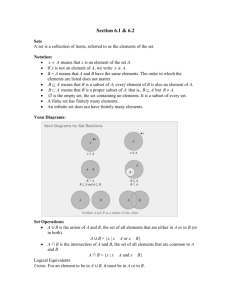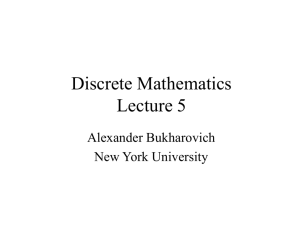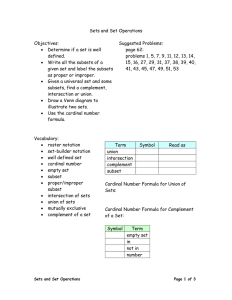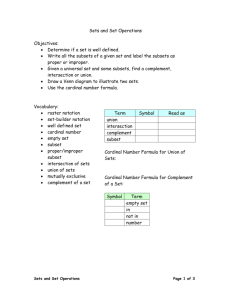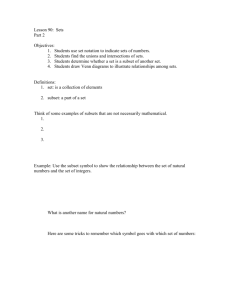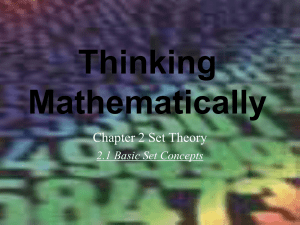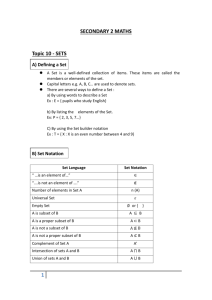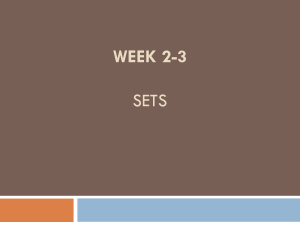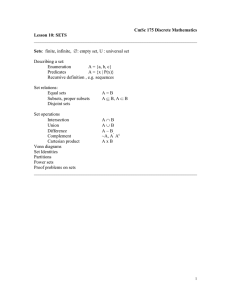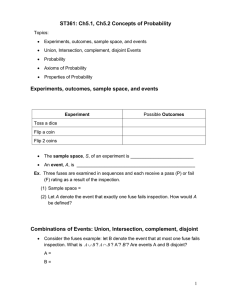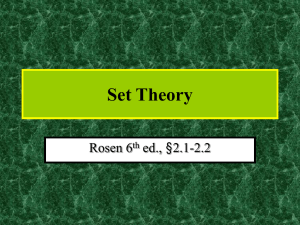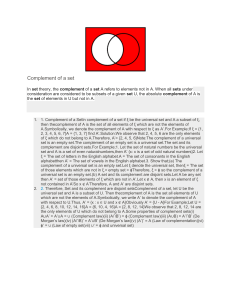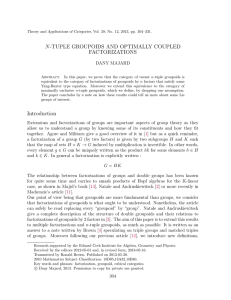Sets
advertisement
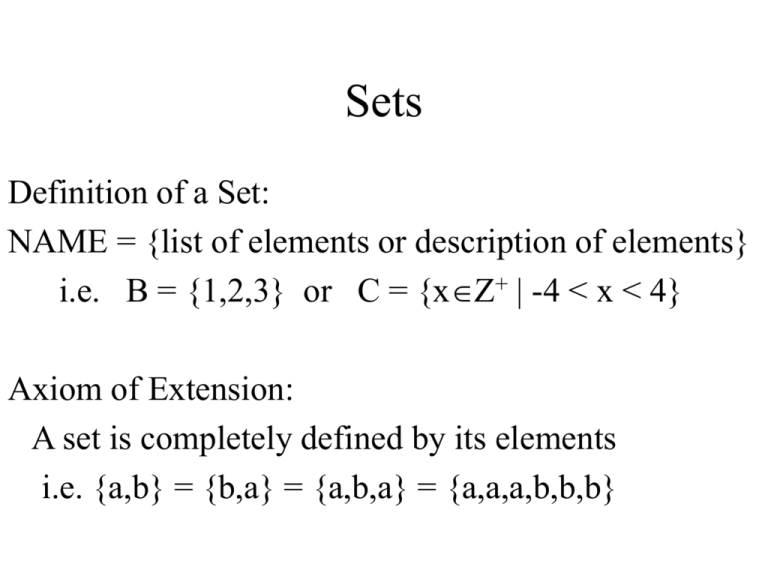
Sets
Definition of a Set:
NAME = {list of elements or description of elements}
i.e. B = {1,2,3} or C = {xZ+ | -4 < x < 4}
Axiom of Extension:
A set is completely defined by its elements
i.e. {a,b} = {b,a} = {a,b,a} = {a,a,a,b,b,b}
Subset
AB xU, xAxB
A is contained in B
B contains A
A B x U, xA ^ xB
Relationship between membership and subset:
xU, xA {x} A
Definition of set equality: A = B A B ^ B A
Same Set or Not??
X={xZ | p Z, x = 2p}
Y={yZ | qZ, y = 2q-2}
A={xZ | i Z, x = 2i+1}
B={xZ | i Z, x = 3i+1}
C={xZ | i Z, x = 4i+1}
Set Operations
Formal Definitions and Venn Diagrams
Union:
A B {x U | x A x B}
Intersection:
A B {x U | x A x B}
Complement:
c
A A' {x U | x A}
Difference:
A B {x U | x A x B}
A B A B'
Ordered n-tuple
and the Cartesian Product
• Ordered n-tuple – takes order and multiplicity into account
• (x1,x2,x3,…,xn)
– n values
– not necessarily distinct
– in the order given
• (x1,x2,x3,…,xn) = (y1,y2,y3,…,yn) iZ1in, xi=yi
• Cartesian Product
A B {(a, b) | a A b B}
Formal Languages
• = alphabet = a finite set of symbols
• string over =
empty (or null) string denoted as
OR
ordered n-tuple of elements
• n = set of strings of length n
• * = set of all finite length strings
Empty Set Properties
1.
2.
3.
4.
Ø is a subset of every set.
There is only one empty set.
The union of any set with Ø is that set.
The intersection of any set with its own
complement is Ø.
5. The intersection of any set with Ø is Ø.
6. The Cartesian Product of any set with Ø is Ø.
7. The complement of the universal set is Ø and the
complement of the empty set is the universal set.
Other Definitions
• Proper Subset
A B A B A B
• Disjoint Set
A and B are disjoint
A and B have no elements in common
xU, xAxB ^ xBx A
AB = Ø A and B are Disjoint Sets
• Power Set
P (A) = set of all subsets of A
Properties of Sets in Theorems 5.2.1 & 5.2.2
• Inclusion
A B A
A A B
A B B
B A B
• Transitivity
A BBC AC
• DeMorgan’s for Complement
( A B)' A' B'
( A B)' A' B'
• Distribution of union and intersection
A ( B C ) ( A B) ( A C )
A ( B C ) ( A B) ( A C )
Using Venn Diagrams to help
find counter example
A ( B C ) ? ( A B) ( A C )
A ( B C ) ? ( A B) C
Deriving new Properties
using rules and Venn diagrams
B ( A C ) ( B A) ( B C )
A B A ( A B)
A B A C A (B C)
Partitions of a set
•
A collection of nonempty sets
{A1,A2,…,An} is a partition of the set A
if and only if
1. A = A1 A2…An
2. A1,A2,…,An are mutually disjoint
Proofs about Power Sets
Power set of A = P(A) = Set of all subsets of A
• Prove that
A,B {sets}, AB P(A) P(B)
• Prove that (where n(X) means the size of set X)
A {sets}, n(A) = k n(P(A)) = 2k


